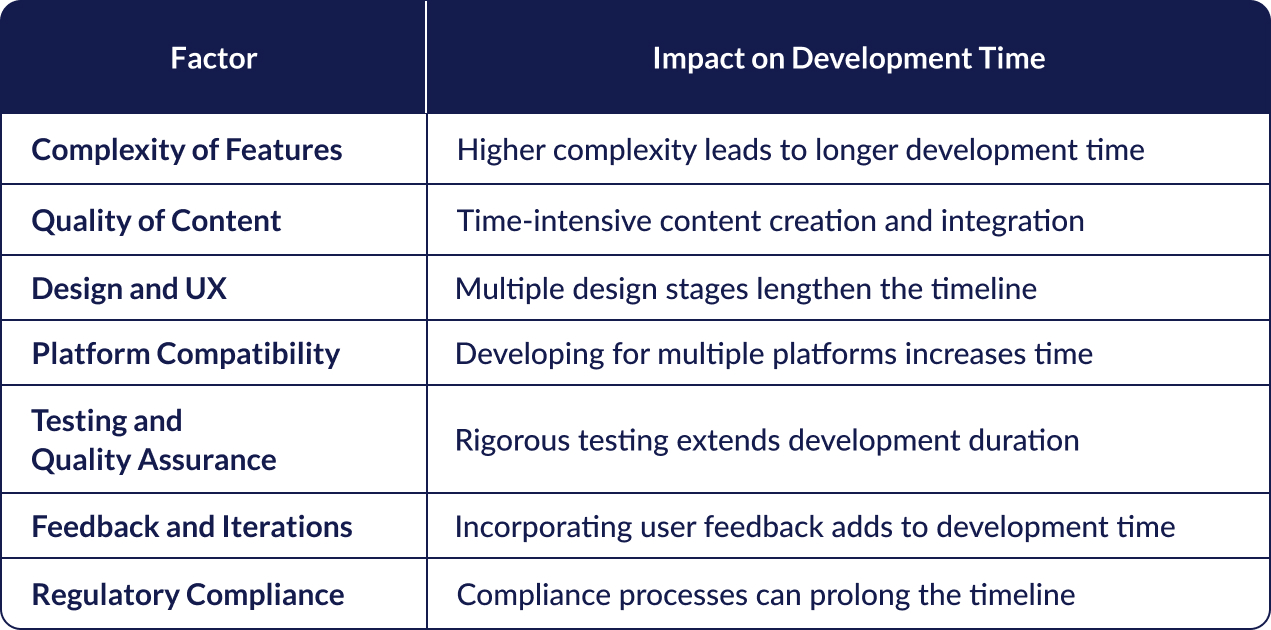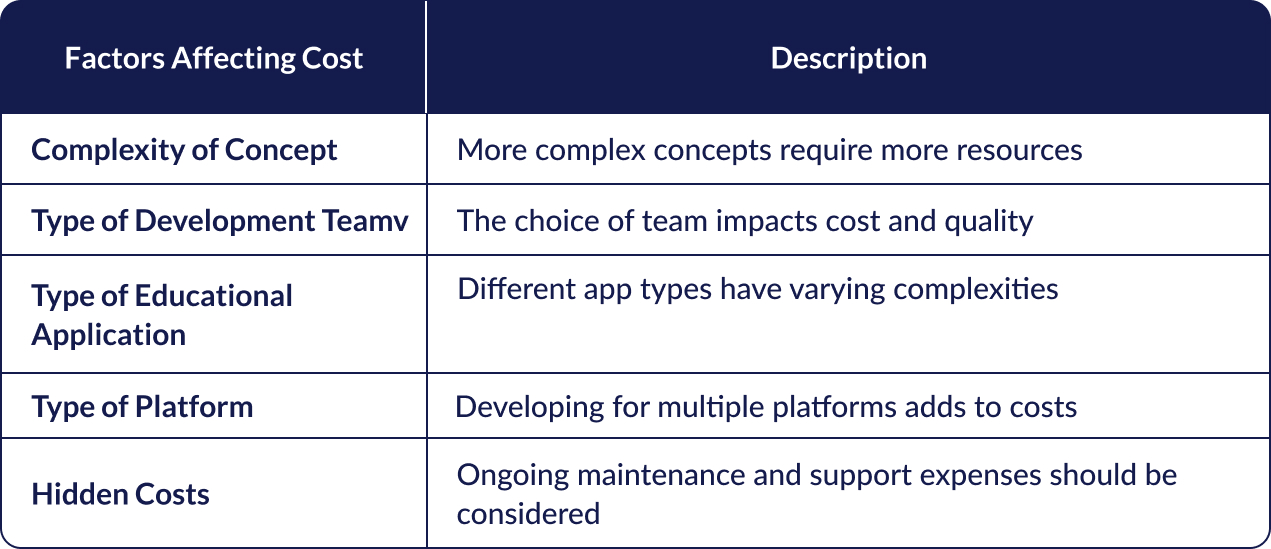In the rapidly evolving landscape of educational technology (EdTech), 2024 stands as a pivotal year. Educational apps have become more than just supportive tools; they are now integral to the learning experience. This article explores the various facets of educational app development, including costs, benefits, challenges, and the factors influencing these aspects.
What is an Education App?
An education app, a cornerstone in the digital transformation of learning, is a software application designed to enhance the educational experience. These apps serve a diverse audience, ranging from young children in elementary education to adults pursuing professional development. Their primary goal is to make learning more accessible, engaging, and efficient.
In essence, education apps are platforms where knowledge meets technology. They can take various forms, including interactive learning modules, video tutorials, quizzes, and even games. Each app is tailored to meet specific educational needs, whether it's mastering a new language, understanding complex scientific concepts, or preparing for competitive exams.
The power of an education app lies in its ability to provide personalized learning experiences. With adaptive algorithms, these apps can cater to the individual learning pace and style of each user. This customization enhances understanding and retention of information. Moreover, they often incorporate gamification elements, which make learning more interactive and enjoyable, thereby increasing user engagement.
Another significant aspect of education apps is their convenience. They allow learners to access educational content anytime and anywhere, breaking the traditional boundaries of classrooms. This flexibility is particularly beneficial for those who cannot access standard educational institutions due to geographical, financial, or personal constraints.
Benefits of Educational Apps
In the digital age, educational apps have emerged as transformative tools in the realm of learning and teaching. These apps offer a multitude of benefits that extend far beyond traditional classroom boundaries, addressing the evolving needs of modern learners. From enhancing accessibility to providing personalized learning experiences, educational apps have redefined how knowledge is acquired and shared. Their impact is felt across various dimensions – mobility, engagement, efficiency, cost-effectiveness, and the breadth of available courses. Each of these aspects contributes to the overall appeal and effectiveness of educational apps, making them an indispensable part of today's educational landscape.
Mobile and Portability
Educational apps offer unparalleled mobile and portability benefits, revolutionizing how and where learning can take place. This mobility allows students to access educational content from anywhere, breaking the traditional classroom boundaries. It's particularly beneficial for learners who are constantly on the move or those who cannot regularly attend physical classes due to various constraints. Mobile apps enable learning during commutes, in waiting rooms, or during short breaks, effectively utilizing time that would otherwise be unproductive. The portability of education apps also extends to different devices, including smartphones, tablets, and laptops, ensuring a seamless learning experience across platforms. For developers, the challenge is to maintain a consistent user experience across various screen sizes and operating systems, which requires significant development effort but greatly enhances accessibility and convenience for the user.
Hire remote Agile team
Get hand-selected expert engineers to build a high-quality Edtech app from scratch.
Increased Engagement
Educational apps significantly boost learner engagement, a critical factor in effective education. These apps often incorporate interactive elements like quizzes, puzzles, and games, making learning more enjoyable and less monotonous. This gamification of education not only attracts learners but also improves retention rates. Interactive elements encourage active participation, as opposed to the passive absorption of information, leading to deeper understanding and better retention of knowledge. Moreover, many educational apps offer instant feedback, allowing learners to understand their progress and areas for improvement in real-time. This immediate feedback mechanism keeps learners motivated and engaged. For developers, creating these interactive and engaging elements demands a deep understanding of educational psychology and user experience design, ensuring that the fun aspects of the app are effectively balanced with its educational objectives.
Time Efficiency
Educational apps excel in offering time-efficient learning solutions. They allow learners to study at their own pace, which is particularly beneficial for those who need more time to grasp certain concepts or, conversely, for quick learners who wish to advance faster. This self-paced learning is not easily achievable in traditional classroom settings. Apps with adaptive learning technologies can tailor content to individual learning speeds and styles, optimizing the time spent on learning. Moreover, the consolidation of resources in a single app – including lectures, notes, quizzes, and additional reading materials – saves time that might otherwise be spent in searching for or accessing these resources separately. For educators and developers, this means designing apps that are not only comprehensive in content but also intuitive in navigation, ensuring that learners spend more time learning than figuring out how to use the app.
Money-Saving
Educational apps can be a cost-effective solution for both learners and educational institutions. For learners, these apps often represent a more affordable alternative to traditional learning methods. They reduce or eliminate educational app development costs associated with physical textbooks, commuting, and sometimes even tuition fees, especially with free or low-cost apps. For educational institutions, apps offer a cost-effective way to provide resources and learning materials to a large number of students, reducing the need for physical infrastructure and materials. Additionally, the scalability of apps means that once developed, they can be distributed to an unlimited number of users at little additional cost. However, it's crucial for developers to balance the quality of content and the app's functionality with the need to keep it affordable. This balancing act ensures that the app remains accessible to a wider audience while still providing value.
A Wide Variety of Courses
One of the most significant benefits of educational apps is the vast variety of courses they offer. This diversity caters to a wide range of interests and educational needs, from academic subjects to skill-based training. Users have the luxury of choosing from a plethora of courses on topics that might not be easily accessible in their local educational institutions. This variety not only includes different subjects but also different levels, catering to beginners, intermediates, and experts alike. For people looking to diversify their skill set or pursue hobbies, these apps provide a convenient and comprehensive platform. From the development perspective, this necessitates a robust platform capable of hosting a diverse range of courses, ensuring smooth operation and easy navigation. It also involves curating and creating quality content that meets the educational standards and expectations of a varied user base.

How Long Does It Take to Build an Education App?
Building an educational app is a process whose duration can vary significantly based on several factors. The complexity of the app's features is a primary determinant; simple apps with basic functions can be developed in a few months, while more sophisticated apps with features like AI-based personalized learning or live streaming can take over a year. The quality and type of content also play a crucial role. Creating and integrating high-quality, engaging educational content, especially if it includes multimedia elements, is time-intensive. Additionally, the design and user experience aspect, which involves multiple stages like wireframing, prototyping, and user testing, can extend the development timeline.
Developing for multiple platforms, such as iOS, Android, and Web can also increase the time needed, even when using cross-platform development tools. Testing and quality assurance, critical for ensuring the app's reliability and user-friendliness, add to the timeline. This includes functional, performance, and security testing, as well as user acceptance testing. Incorporating feedback from beta testing and early users often leads to further iterations, which are essential but time-consuming.

Risks and Challenges of Building an Education Application
Building an educational application comes with its own set of risks and challenges that developers and educators need to navigate. One of the primary challenges is ensuring the engagement and retention of users. Educational apps must be captivating enough to compete with the myriad of distractions available to users, especially younger audiences. Another significant challenge is creating content that is not only informative but also pedagogically sound and aligned with educational standards. This involves a deep understanding of educational theories and curriculum design.
Technical challenges include ensuring data security and user privacy, particularly when dealing with children's data, which is subject to stringent regulations like COPPA (Children's Online Privacy Protection Act) in the United States. The app must be robust against cyber threats and protect sensitive user information.
Another challenge lies in achieving a balance between accessibility and profitability. While it's essential to make the app accessible to a broad audience, including those with limited financial resources or disabilities, the app must also be financially viable. This often requires innovative business models and pricing strategies.
Scalability is also a critical concern. The app should be able to handle a growing number of users and an expanding library of content without compromising performance. This requires scalable architecture and efficient content management systems.
Furthermore, for apps used in formal education settings, compliance with educational standards and data protection regulations is crucial, and the process of ensuring compliance and obtaining necessary approvals can extend the development timeline.

Why Is It a Good Idea to Create an EdTech Startup Right Now?
The current market trends indicate a growing demand for digital education solutions. Starting an EdTech company now could be a strategic move, but it requires a significant time investment in market research, development, and marketing.
- Growing Market Demand: The demand for digital learning solutions has been steadily increasing. This is driven by the growing recognition of the importance of lifelong learning and the need for flexible learning options. The global shift towards online education, accelerated by recent events like the COVID-19 pandemic, has highlighted the need for quality EdTech solutions.
- Technological Advancements: There have been significant advancements in technology, such as AI, VR, and cloud computing, which have opened new possibilities for innovative educational tools. These technologies enable personalized learning experiences, interactive content, and better accessibility, making education more engaging and effective.
- Investment and Funding Opportunities: The EdTech sector has seen a surge in investment and funding. Investors are increasingly interested in startups that offer innovative solutions to education challenges. This influx of capital makes it a conducive environment for new ventures.
- Changing Educational Paradigms: There is a shift in educational paradigms, with more emphasis on skills such as critical thinking, adaptability, and digital literacy. EdTech startups have the opportunity to lead this change by providing platforms that cater to these evolving educational needs.
- Global Reach: Digital platforms allow EdTech startups to reach a global audience. The potential to impact education at a global scale presents a massive opportunity for growth and influence.
- Government and Institutional Support: Many governments and educational institutions are now more open to adopting digital education solutions. This shift presents an opportunity for EdTech startups to collaborate with these institutions, providing a potentially stable revenue stream and a platform for impact.

Factors Affecting The Cost Of EdTech Application Development
The development of an EdTech application is a complex undertaking influenced by various factors.
How much does it cost to make an educational app? Understanding these factors and their cost implications is crucial for planning and budgeting. Whether you're envisioning a simple quiz app or an AI-powered adaptive learning platform, the cost of development can vary significantly. This article explores the key determinants of educational app development costs, including the complexity of the concept, the choice of the development team, the type of educational application, the platform for deployment, and hidden cost of developing education app that can arise during the development process. By delving into these factors, you'll gain valuable insights into how to manage your EdTech project's budget effectively while delivering a high-quality educational experience.
The Complexity of the Concept
The complexity of an EdTech application's concept is a critical factor influencing educational app development cost. The more intricate the features and functionalities, the more resources and time are required for development. For instance, a simple quiz app may have a lower development cost compared to an AI-powered adaptive learning platform. This complexity can be quantified by assessing the number of features, the sophistication of algorithms, and the level of interactivity.

The Type of Development Team
The choice of a development team significantly impacts both the cost and quality of an EdTech application. There are three primary options: in-house development, hiring freelancers, or partnering with a development agency. Each has implications on its elearning app development cost.

Type of Educational Application
The nature of the educational application also influences development costs. Different types of EdTech apps, such as Massive Open Online Courses (MOOCs), interactive learning platforms, and virtual laboratories, have varying levels of complexity and feature requirements.

Type of Platform for Your Educational Application
Developing an EdTech app for different platforms, such as iOS, Android, and web, affects the development cost. Each platform requires separate development efforts, adding to the overall cost of developing education app.

Hidden Cost of Developing an EdTech App
There are often hidden educational app development costs that should not be overlooked. These include ongoing maintenance, server costs, content updates, and user support. While they may not be as apparent during the initial development phase, they are essential for the long-term success of the app and should be factored into the overall budget.
How much does it cost to make an educational app? This table provides a summary of the factors influencing the elearning app development cost:

How to Build an Educational App?
Building an educational app involves several key steps, from conceptualization to deployment. Here's a comprehensive overview of how to build an educational app:
1. Research and Ideate
- Identify Your Target Audience: Determine the age group, educational level, and specific needs of your target users. Understanding your audience is crucial for designing relevant content and features.
- Market Research: Analyze the existing EdTech market to identify gaps and opportunities. Assess competitors' offerings and gather insights into user preferences and pain points.
- Define Learning Objectives: Clearly outline the educational goals and outcomes your app aims to achieve. This forms the foundation for content creation and app design.
2. App Design
- User Interface (UI) and User Experience (UX) Design: Design an intuitive and visually appealing user interface. Focus on creating a seamless user experience that prioritizes ease of navigation and engagement.
- Content Planning: Develop a content strategy that aligns with your learning objectives. Organize content into modules, lessons, or courses, considering factors like curriculum structure and progression.
- Interactivity and Engagement: Incorporate interactive elements such as quizzes, gamification, and multimedia content to enhance user engagement and learning outcomes.
3. App Development
- Select the Tech Stack: Choose the appropriate technology stack for your app development, considering factors like platform compatibility and scalability.
- Frontend and Backend Development: Develop the frontend (user interface) and backend (server, database) components of your app. Ensure that they work seamlessly together to deliver a cohesive user experience.
- Integrate Features: Implement features like user profiles, progress tracking, and content delivery systems. If applicable, incorporate AI or machine learning algorithms for personalized learning experiences.
4. App Deployment
- Testing: Conduct thorough testing to identify and rectify bugs, usability issues, and performance bottlenecks. User acceptance testing (UAT) involving real users can provide valuable feedback.
- Optimize for Platforms: If you're targeting multiple platforms (iOS, Android, Web), ensure the app is optimized for each platform. Cross-platform development tools can streamline this process.
5. User Feedback and Iterations
- Beta Testing: Release a beta version of your app to a select group of users to gather feedback. Use their insights to make improvements and refine the app.
- Continuous Improvement: Regularly update the app based on user feedback and changing educational needs. Keep content fresh and relevant to maintain user engagement.
6. Launch and Marketing
- App Store Submission: Submit your app to app stores (e.g., Apple App Store, Google Play Store) following their guidelines and requirements.
- Marketing Strategy: Develop a marketing strategy to promote your app. Utilize digital marketing, social media, content marketing, and partnerships with educational institutions to reach your target audience.
- Monetization: Decide on your app's monetization model, whether it's through subscriptions, in-app purchases, ads, or a freemium model.
7. Support and Maintenance
- User Support: Offer customer support channels for users to seek assistance or report issues.
- Content Updates: Regularly update and expand your app's content to keep it current and engaging.
- Security and Compliance: Ensure data security and compliance with relevant regulations, especially if dealing with user data, including children's data.
Building an educational app is a dynamic process that requires ongoing attention to user needs and technological advancements. By following these steps and remaining responsive to user feedback, you can create an educational app that effectively meets the needs of your target audience and contributes to their learning journey.
How Can Axon Help You with Educational App Development?
Axon specializes in efficient and effective EdTech app development, offering expertise in creating engaging and innovative learning solutions. Our team can help streamline the development process, ensuring your app is delivered on time and within budget.
.png)
Contact us to get a detailed consultation on your project!

%20(1).png)

